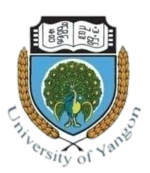
Back جامعة يانغون Arabic جامعة يانجون ARZ ရန်ႏတကုင်ႏတက္ကသိုလ်ႏ BLK ইয়াঙ্গুন বিশ্ববিদ্যালয় Bengali/Bangla Unibersidad sa Yanggong CEB Universitato de Jangono Esperanto Universidad de Yangon Spanish Yangonin yliopisto Finnish Université de Rangoun French Universitas Yangon ID
 Seal of Yangon University | |
| Latin: Universitas Rangunensis | |
Former names |
|
|---|---|
| Motto | နတ္ထိ ဝိဇ္ဇာ သမံ မိတ္တံ (Pali: natthi vijjā samaṃ mittaṃ)[1][2][3] |
Motto in English | There's no friend like wisdom. |
| Type | Public |
| Established | 1878 |
| Rector | Dr. Tin Mg Tun |
Academic staff | 1313 |
| Undergraduates | 4194 |
| Postgraduates | 5748 |
| Location | , , 16°49′48″N 96°08′06″E / 16.83000°N 96.13500°E |
| Campus | Urban |
| Affiliations | ASEAN University Network (AUN), ASAIHL |
| Website | uy |
The University of Yangon (also Yangon University; Burmese: ရန်ကုန် တက္ကသိုလ်, pronounced [jàɰ̃ɡòʊɰ̃ tɛʔkəθò]; formerly Rangoon College, Rangoon University and Rangoon Arts and Sciences University), located in Kamayut, Yangon, is the oldest university in Myanmar's modern education system and the best known university in Myanmar. The university offers mainly undergraduate and postgraduate degrees (Bachelor's, Master's, Post-graduate Diploma, and Doctorate) programs in liberal arts, sciences and law. Full-time bachelor's degrees were not offered at the university's main campus after the student protests of 1996. The bachelor's degree was re-offered from 2014 on. Today degrees in Political Science are offered to undergraduate students, as well as postgraduate diplomas in areas such as social work and geology.
Initially most major universities in the country depended on Yangon University. Until 1958 when Mandalay University became an independent university, all institutions of higher education in Myanmar were under Yangon University. After the University Education Act of 1964, all professional colleges and institutes of the university such as the Institute of Medicine 1, Rangoon Institute of Technology and Yangon Institute of Economics became independent universities, leaving the Yangon University with liberal arts, sciences and law. In Myanmar, responsibility for higher education depends on various ministries. The University of Yangon depends from the Ministry of education.[4]
Yangon University has been at the centre of civil discontent throughout its history. All three nationwide strikes against the British administration (1920, 1936 and 1938) began at Rangoon University. Leaders of the Burmese independence movement such as General Aung San, U Nu, Ne Win and U Thant are some of the notable alumni of the university. The tradition of student protest at the university continued in the post-colonial era—in 1962, 1974, 1988 and in 1996.[5]
- ^ https://www.myanmardigitalnewspaper.com/en/motto-university-yangon-and-influence-pali
- ^ https://www.moi.gov.mm/article/9437
- ^ https://www.mdn.gov.mm/en/node/110204
- ^ Cite error: The named reference
jameswas invoked but never defined (see the help page). - ^
Zin Linn (20 November 2012). "President Obama rejuvenates Rangoon University of Burma". Asian Correspondent. Bristol, England: Hybrid News Limited. Archived from the original (News & blogging) on 17 January 2013. Retrieved 20 November 2012.
People of Burma ... satisfied with the choice of a venue made by the US President ... the convocation hall of the University of Rangoon....